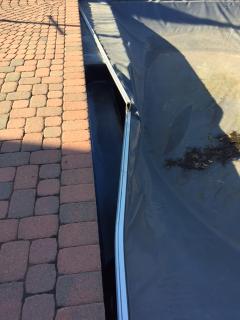
Automatic Safety Pool Cover - Winter Care
An automatic safety pool cover is probably the most common addition to any fiberglass pool. We install an auto cover on over half of the fiberglass pools we build.
The main features of an auto cover is that they keep the inground pool safe, increase energy efficiency, and keep the pool clean. The not so obvious benefit is that an auto cover can also serve as your winter cover saving you the cost of a winter mesh cover. It also means you don’t have to drill the holes in your deck that are needed for a winter cover. If you choose to go this route (and it really is a great way to go) there are a few things you will need to keep in mind and pay attention to through the fall closing and winter.

Tracks pulled out of retainers
due to snow load and water level
being too low
First and foremost you must keep your cover pump on to remove water no different from during season. Make sure that the plug is connected to a good GFCI outlet and is not subject to direct rain and could trip and there for not operate the pump. Simple.
In northern regions during the winter, the cover is going to carry some level of snow and ice on it not initially pump-able by your cover pump. With this weight it is important that the water in the swimming pool is left at normal operating level (or as close as possible) so that the water / snow / ice is supported as it collects on the top of the cover. This means that the skimmers will remain full and will need to be protected from freezing with a solid foam material such as pieces of polystyrene or pieces of swim noodles.
This support of the snow and ice load is critical. If the swimming pool water is lowered (or allowed to lower during winter through a pool overflow drain) the snow / ice load will push down on the cover until the cover is pulling tight. Once the cover is tight, the weight of the snow / ice is horizontally bearing on the tracks, cover fabric, and cover webbing. This is a dangerous place for your cover as a couple bad things could happen.
Being able to pump the water off as it melts is a no-brainer and best practice. The second option if pumping doesn’t work out is shoveling the snow (nothing sharp that could cut the fabric) before the fabric or tracks are damaged. If the load is allowed to collect and has pulled the cover tight, the cover can pull out of the retainers or the fabric itself can rip until the water drains into the swimming pool to release the pressure. Though costly a damaged track or ripped fabric is still reasonably repairable.
The last and worst case scenario is thankfully rarer. If the load is left on the cover and the tracks hold in the retainers (the part that’s embedded in the concrete) the tracks can pull the concrete or swimming pool wall apart as the retainers are forced in towards the water from the weight. Unfortunately this requires some degree of concrete work and can require the rework and or repair of the pool wall itself.
The solution to avoid this to keep the pool water level FULL at winterization, keep your cover pump working, and PAY ATTENTION to your cover.
Pool Article Categories:
Copyright Luxury Pools and Living 2005-2024
Cookie Policy | Privacy Policy